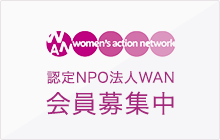In the 1970’s, when the movement opposing compulsory special school education was active, I voluntarily came back to Tokyo from Kyoto for the care of my mother-in-law who had cancer. I indulged in the life solely assuming the expected role of “caring”, going back and forth between the hospital and home. I was locked up in my house but did not question the life of “housewife-like situation” at all.
One day, a flyer blown by the wind had dropped in front of the hospital and caught my attention. It was an ad for the movie, “Goodbye CP (cerebral palsy)”. It aroused my interest and I felt like seeing the film. It was a movie produced by Shippu Production in 1972, depicting a handicapped person, unable to walk on two feet, but getting around in the town on knees with his body twisting. It was a film exposing something “different” to the light of day in an ordinary “homogenous” town. The guy who walked on the street is Hiroshi Yokota, chairman of Kanagawa branch of Aoi-shiba-no-kai1). Director: Kazuo Hara.
I participated in the student group activities to care for the disabled after being asked to help “T” with whom I met for the first time at the Chapel Hour at Doshihsa University’s lecture program open to the public.
Before long, I began going out with the disabled as a member of the group who supported the independency of disabled by providing them with 24-hour care in shifts. It was normal in those days for the Japan Railways (public railway system prior to becoming a private enterprise) to reject disabled people to board trains and restaurants not allowing their admission. In such cases, I often got furious and had serious arguments with the customer services there. But it was always the disabled that soothed me and dismissed those incidents casually by saying, “Don’t get so upset. Take it easy.”
I once helped a disabled woman who started living alone in the local area with strong determination to “move out from home and not wanting to live in institutions.” I helped her for several years and got involved in her personal life, during which time she got married and had a child. In those days the remnants of students’ movement were still around. The students in the group worked diligently and were very gentle. They were somewhat weird but merry.
Mr. Koichi Yokotsuka, the first chairman of Aoi-shiba-no-kai, said, “Being thoughtful is not to feel reserved towards able-bodied people. We, as physically challenged with CP, must be thoughtful but at the same time be assertive. In some cases, we have to use able-bodied caregivers to the fullest extent even if we are aware it will exhaust them and possibly lead to their collapse.” (“Mother, don’t kill me.” 1975, by Suzusawa Shoten.)
He is said to love Shinran’s2) words in “Tanni Sho”, “よきひとのおほせをかふりて信じるほかに別の子細なきなり (I simply believe my mentor Honen’s words, and nothing else, “Do pray with, Nenbutsu, Buddhist chants and be saved by Amitabha, a celestial Buddha”) ” He probably wanted to reflect relationship between Shinran and Honen”3) over the extremely strained relationship between the handicapped and their caregivers.
I often took my elementary-school daughter at the time to this group’s activities. One day she asked me while we were taking a bath, “Why did God produce disabled people?” I answered, “People with disabilities are born in fixed ratio in the same way people with other characteristics are born.” It is natural that there are strong people, weak people, and people different from you in the world. Besides, it is not so unhappy to be disabled.” “Is that so…” my daughter answered pondering deeply over my words.
She is now in her 40’s and she had her first child at the age of 41. She gave birth to a baby who happened to come after 15 years of marriage. In spite of her age, she rejected prenatal diagnosis by amniocentesis. And when her child was a year and a half, she got a divorce. As a single mother, she lives a struggling life with her two year and a half daughter who is getting more and more assertive.
Eugenic Protection Law’s revision bill was laid on the table in 1972 and 1973, trying to eliminate “the economic status condition3ª” to legal abortion and include “fetus status condition4)”. “However, due to the strong opposition movement by women and the disabled advocates, the bill was shelved and finally damped in 1974.”
10 years later, in 1982, a Diet member, Masakuni Murakami of the Liberal Democratic Party then (a member of Seicho-No-Ie (House of Growth), a world’s largest New Thought Group) tried to submit the revision bill to the Diet again, wishing to eliminate “economic status condition” without referring to “fetus status condition”. However, because of nationwide opposition movements and local governments’ adoption of petitions, majority of Diet members took cautious stance and judged the bill “ahead of time prior to legalization” and in March 1983, the idea of submitting the bill was given up.
Then why didn’t 1982’s bill to revise Eugenic Protection Law refer to “fetus status condition”? That is because the revised Maternal and Child Health Act had already included this “fetus status” provision. The preparation to revise the Maternal and Child Act started in 1976 and steadily and successfully they pulled of revision of this law.
It turned out that the original purpose to revise the Maternal and Child Health Act is as mentioned in the Article One of Eugenic Protection Law – “to prevent birth of inferior descendants from the eugenic point of view, and to protect life and health of mother, as well.” The revision was bolstered by the following governmental policy in late 70’s as well – “Vision of Enhancement of Family Foundation” – mainly asserted by the late Prime Minister Masayoshi Ohira. On top of that, another purpose for the revision of Maternal and Child Health Act was to divide the coalition of women and the disabled advocates by undertaking the “economic status condition” and “fetus status conditions” separately by different laws.
And now, new compulsory prenatal diagnosis is about to be legalized in Japan. “In October this year, some 10 medical facilities will start clinical tests of new prenatal diagnosis by which three chromosomal abnormalities including Down Syndrome can be identified with high precision from pregnant women’s blood. Test is aimed to offer pregnant women at age of 35 and older from their 10thweek of pregnancy. In the case of Down Syndrome, its abnormalities can be identified with 99.1% precision. Since unlike the conventional test method, having blood test in early pregnancy alone can conduct diagnosis, which creates concerns for inducing abortion, leading to the ‘selection of life.’ The backdrop of introduction of new test is rapidly increasing in cases of late marriages and late childbearing. According to Population Survey Report in 2011, average first birth age is 30 years old and older. One forth of newly born babies in 2011 bore from advanced-aged pregnant women.” (Tokyo Shin bun)
I also suspect that there is a fear of radiation concerning the Fukushima Daiichi Power Plant Explosion brought about by Great Eastern Japan Earthquake. Under the circumstances, the weakest “fetus” is obliged to be the biggest sacrifice. Furthermore, those who are forced to make this heavy decision are women.
In the history of women’s liberation movements, women claimed their right for abortion as the right of self-determination, with slogan, “‛ to breed or not’ is women’s choice,” while disabled people shouted, “Mother, don’t kill me!” concerning “fetus status condition.” (I do want to say “Do not flee, men!” as enantiosis.) Why did women and the disabled have to be at loggerhead? In the past two opposition movements towards revision of Eugenic Protection Law, no right answer was given. Current new compulsory prenatal diagnosis legalization move will give heavier burden to day-to -day life of women and the disabled in the context of integration of administrative and science/ medical organization.
On December 23, 2012, gatherings will be held in Tokyo and Osaka related to new compulsory prenatal diagnosis: “Let’s talk about new prenatal diagnosis test” in Tokyo, organized by Voice from High-Risk Women/ Soshiren “From Women’s (Our) Body” “Is it Good thing to know whether or not your fetus has ‘disabilities’ just by blood test?” in Osaka, organized by Reproduction Medicine and Discrimination (picture-card shows project), co-organized by Kyoto Parental Group of Down Syndrome Children “Triangle”.
On December 16thin Japan, the general election of the Lower House ended. The result was as assumed. What a disaster! Just like a period of final days of Weimar Republic, I am afraid that based on concept of eugenics, Japan is steadily proceeding to the road to fascism. Whenever I think of the future of Japanese young people, I get profoundly depressed.
Translator’s notes
1. Aoi-shiba- no-kai: A society of people with cerebral palsy who aim to be free from restriction to remain at home and live not in an institution for the disabled but live independently in town with the help of caregivers.
2. Shinran: (1173 –1263) was a Japanese Buddhist monk, who was born in Kyoto at the turbulent close of the Heian period and lived during the Kamakura period. Shinran was a pupil of Honen and the founder of what ultimately became the Jodo Shinshu sect in Japan.
(from Wikipedia: http://en.wikipedia.org/wiki/Shinran)
3. Honen: (1133 –1212) is the religious reformer and founder of the first independent branch of Japanese Pure Land Buddism called Jōdo-shū (“The Pure Land School”). Hōnen became a monk of the Tendai sect at an early age, but grew disaffected, and sought an approach to Buddhism that anyone could follow, even during the perceived Age of Darma Decline. He taught people to recite the Buddha’s name or nembutsu to be saved.
(from Wikipedia: http://en.wikipedia.org/wiki/Hōnen)
4. “the economic status conditionª” / 5. “fetus status condition”
The points of revision bill in 1972, and 73 were the elimination of the “economic status” from the possible conditions of abortion, and the insertion of “fetus status” provision in this law. For women’s right advocates, elimination of “economic status” means reducing women’s self decision right to breed or not to breed. For the disabled, insertion of additional “fetus status” provision means possible increase of abortion of fetus having abnormalities in expanded lists of disorders.



![[広告]広告募集中](https://wan.or.jp/assets/front/img/side_ads-call.png)









